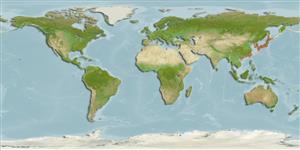Common names from other countries
Bivalvia |
Venerida |
Cyrenidae
Environment: milieu / climate zone / depth range / distribution range
Ecology
Benthic; brackish; depth range 0 - 6 m (Ref. 385). Subtropical
Northwest Pacific: from south of Japan to the south of Sakhalin.
Length at first maturity / Size / Weight / Age
Maturity: Lm ?, range 2 - ? cm Max length : 4.0 cm SHL male/unsexed; (Ref. 127304); max. reported age: 10 years (Ref. 127304)
Found in subtidal areas of estuaries in mud (Ref. 75831). Infaunal suspension-feeder (Ref. ).
Life cycle and mating behavior
Maturity | Reproduction | Spawning | Eggs | Fecundity | Larvae
Life cycle: Embryos develop into free-swimming trocophore larvae, succeeded by the bivalve veliger, resembling a miniature clam (Ref. 833).
SAUP Database. 2006. (Ref. 356)
IUCN Red List Status
(Ref. 130435: Version 2025-1)
CITES status (Ref. 108899)
Not Evaluated
Not Evaluated
Threat to humans
Human uses
Fisheries: commercial
FAO - Fisheries: landings, species profile | FishSource | Sea Around Us
Tools
More information
PhysiologyOxygen consumption
Human RelatedStamps, coins, misc.
Internet sources
Estimates based on models
Preferred temperature
(Ref.
115969): 5.6 - 22.6, mean 14 (based on 372 cells).
Resilience
High, minimum population doubling time less than 15 months (K=0.2-1.11; tm=3; tmax=10).
Fishing Vulnerability
Low to moderate vulnerability (29 of 100).
Price category
Unknown.
Nutrients : Calcium = 149 [71, 228] mg/100g; Iron = 8.53 [1.95, 15.11] mg/100g; Protein = 9.88 [8.64, 11.12] %; Omega3 = 0.313 [0.202, 0.423] g/100g; Selenium = 61 [50, 72] μg/100g; VitaminA = 0 μg/100g; Zinc = 2.04 [0.56, 3.51] mg/100g (wet weight); based on
nutrient studies.
